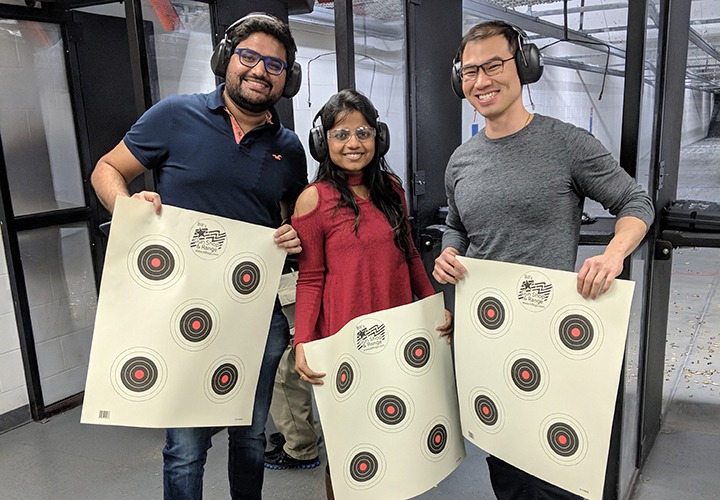 Back to News
Back to News
Image Source: Instagram/Canik USA
May 9, 2025
Oakland’s Billboard Ban is Gross First Amendment Violation
A recent controversy over a billboard in Oakland, California, has brought to light the city’s troubling firearm and ammunition advertising restrictions. The billboard advertised Turkish firearm manufacturer Canik’s Mete MC9 pistol.
Local media reported that many Oakland residents expressed “shock and outrage” over the billboard, which featured a photo of the handgun with the innocuous message: “Mete MC9 Canik Comes to California.” The billboard promoted the pistol’s introduction to the California market, as the Mete MC9 is compliant with California’s strict gun laws and was earlier this year added by the California Department of Justice to its roster of handguns approved for sale in the state. Not long after the news broke highlighting the “controversy” over the billboard, the ad was reportedly taken down.
View this post on Instagram
Permit Required
A public information officer for the city of Oakland told the news media that the ad fell under a little-known provision of the city’s municipal code that regulates any person or company “engaged in the business” of selling firearms or ammunition and requires that those entities obtain a permit from the Oakland Police Department. The City Council adopted the ordinance in 1992 and justified the permitting scheme on the theory that a “considerable proportion of the firearms used in violent crimes were obtained illegally from unlicensed firearms dealers,” and the costs of those crimes are borne by taxpayers.
Rather than focus on firearm retailers that make sales within the city, the definition of a regulated “firearms dealer” under the ordinance curiously extends to any person “advertising for sale, transfer, or lease, or offering or exposing for sale, transfer, or lease, any firearm.” The costs of compliance are not cheap. According to local reporting, a permit to advertise firearms in Oakland pursuant to the ordinance is $874 and annual permit renewals cost $584 per year. The ordinance also requires that advertisers obtain liability insurance with at least $1 million in coverage.
Targeting Firearm-Specific Speech
The ordinance seems like it should only apply to firearm dealers with physical operations in the city of Oakland, as it gives city officials the right to “enter the building designated in the permit” for inspection purposes, and it would not be reasonable to assume that city officials would have the ability to enter premises outside of its jurisdiction (and in Canik’s case, in a foreign country). However, it appears that the City of Oakland interpreted the “advertising” language to apply to Canik’s billboard, as it cited the lack of a permit for the advertisement as a justification for removing it. But in any event, the targeting of firearm-specific speech – even if it is commercial speech – for additional regulation is constitutionally suspect.
The Supreme Court explained in Central Hudson Gas & Electric Corp. v. Public Service Commission of New York that when a law restricts commercial speech, the court first asks whether the regulated speech is misleading or involves unlawful activity, as neither type of speech is protected by the First Amendment. But if the speech is neither misleading nor related to unlawful activity, then the government has the burden of showing that the law directly and materially advances a substantial governmental interest and that the law is not more extensive than necessary to serve that interest.
Oakland’s ordinance requiring a firearm retailer to obtain a permit and expensive liability insurance before it can advertise a lawful product would face significant hurdles under the Central Hudson test, especially as applied to the Canik ad. The billboard certainly passes the first step, as Canik was simply promoting a pistol that has been approved for California’s arduous handgun roster and which residents can lawfully acquire (after jumping through the many hoops imposed by the Golden State, of course). Indeed, Canik’s ad could not be less controversial, as it simply depicted the pistol and made a truthful factual statement it was available in the state and cannot be construed as misleading or encouraging violence or criminal acts.
Moving onto the second step, the City of Oakland provided in the “findings” section of the ordinance that it enacted the regulation to curb illegal firearm sales and violent crime. It is difficult to see how prior restraint on all firearm advertisements directly or materially advances this interest. And even if the restriction could significantly curb the criminal misuse of firearms and unlawful sales, the ordinance imposes an excessive burden on protected speech because it is not limited to speech on those categories. Rather than targeting advertisements that encourage criminal misuse of firearms or unlawful products, the ordinance arguably sweeps in all advertisements in which a firearm is potentially “exposed” for sale, even those that are completely legal to own in California.
Not California’s First Time
Unfortunately, Oakland’s ordinance is not the first time that a government in California has tried to restrict protected, firearm-related speech under the guise of curbing violence. The permitting regime is reminiscent of similar laws that in recent years have thankfully been struck down as unconstitutional under the First Amendment.
In Tracy Rifle & Pistol LLC v. Harris, a group of firearm retailers successfully sued then California Attorney General Kamala Harris over a California law banning the depiction of handguns on advertisements for the sale or transfer of those firearms on any part of the business’s premise that could be readily seen from outside. In 2018, the U.S. District Court for the Eastern District of California granted summary judgment in favor of the plaintiffs, holding that the law violated the First Amendment.
First, the court concluded that on-site handgun advertisements were protected speech under the Central Hudson test because they concern lawful activity – i.e., purchasing a handgun from a licensed dealer – and were not misleading. The court went even further and determined that buying a handgun from a licensed retailer is not only lawful but is constitutionally protected under the Second Amendment. After all, you cannot “keep” a firearm if you do not have a corresponding right to acquire (buy) it.
At the second step, the court concluded that the law did not directly and materially advance the government’s asserted interests in reducing handgun suicide or handgun crime, as it found that the government’s aim of stopping law-abiding citizens from making “impulsive” handgun purchases was unsubstantiated by any evidence and impermissibly paternalistic. Likewise, the court determined that the on-site handgun ad ban targeted more speech than was necessary to further the government’s interests, as the state already places significant limits on handgun purchases, including a 10-day waiting period, limiting consumers to one handgun purchase within a 30-day period and requiring that purchases complete a firearm safety program. Thus, the court concluded that the government had an array of policy choices to try to accomplish its goals – including creating education campaigns targeted at underlying causes of the societal problems it had identified – and could not infringe upon the First Amendment rights of retailers as a workaround.
More recently, the U.S. Court of Appeals for the Ninth Circuit held in Junior Sports Magazines v. Bonta that California’s law prohibiting advertisements promoting any firearm-related product in a manner that is “designed, intended, or reasonably appears to be attractive to minors” violated the First Amendment. The Ninth Circuit reversed the district court’s denial of a preliminary injunction, concluding that the plaintiff was likely to succeed on the merits because California failed to justify its infringement of protected speech under the Central Hudson test.
The court explained that the law regulates speech that is not misleading and concerns lawful activity, as California law allows minors (under adult supervision) to possess and use firearms for lawful activities such as hunting and shooting sports. And the state provided no evidence whatsoever that the law advances its interests in preventing unlawful possession of firearms by minors or reducing gun violence. Likewise, the court determined that the law was more extensive than necessary, as it was not limited to speech relevant to the state’s interests, such as targeting ads encouraging minors to illegally buy firearms or to use firearms unlawfully.
These cases demonstrate that blanket restrictions that specifically target firearm-product advertising are unlikely to pass constitutional muster under the Central Hudson test. This is especially true in as-applied challenges to restrictions on advertisements – such as Canik’s – that promote lawful purchase of lawful products. These examples show that governments are willing to take any means necessary – including violating someone’s First Amendment rights – to discourage the exercise of Second Amendment rights. But the coercive power of the state should not and cannot be used to eliminate a pro-Second Amendment viewpoint from public discourse.
Shelby Baird Smith is NSSF’s Chief Litigation Counsel.
You may also be interested in:
Court-Shopping for Biased Benches Nothing New to Firearm Industry
N.Y. Lawmaker is California Dreaming of Flawed Gun Owner Liability Insurance Mandate
Categories: BP Item, Featured, Government Relations, Top Stories









